The notes for this course began from a series originally
written by Tim Ng, with extensions by
David Cash and
Robert Rand. I have modified them to follow our course.
Proofs on Graphs
Now that we've gotten some definitions out of the way, we can talk about why we care about why graphs are
a whole unit in this course. Of course graphs are an important structure in computer science, but it turns out
that reasoning about them can be surprisingly tricky. This unit is intended to show you what the point of working
through the previous two units was. Number theory and combinatorics may not come up directly in CS very often, but each
of them taught us some very important lessons about writing proofs and solving problems that will help us with graphs.
Graphs, as in Unit 1, are well-defined items with rigorous definitions that need to be argued about. Writing proofs
on graphs requires us to be logically consistent, to structure our argument well, and to sometimes be creative with
how we manipulate the objects we are given to create new ones.
That said, more like Unit 2, graphs also have a lot of properties that can be argued about through analog or
comparison. They definitely feel more tangible than the natural numbers themselves, and lend themselves to the
ability to make arguments more like Unit 2 that rely to some extent on the intuition we have about what these objects
are like.
Let's look at an example.
Let $G$ be a graph and $u,v,w$ be vertices. If
there exists a path from $u$ to $v$ and a path from $v$ to $w$,
then there exists a path from $u$ to $w$.
The obvious thing to do here, of course, is to string together our two paths. In
real life, if there's a path from $u$ to $v$ and a path from $v$ to $w$, then clearly
if we want to go from $u$ to $w$ we'd just walk from $u$ to $v$ and from $v$ to $w$.
However, remember that a path, as defined, can not repeat any vertices! Consider the
following graph. Here, the first path goes from $u$ to $v$ and
is highlighted in red. The second path from $v$ to $w$ is in blue. If one
naively takes the union of the paths, then the result is not a path (for
example, it has a cycle).
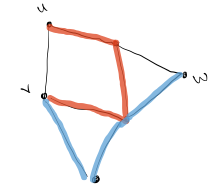
However, this picture also gives us a sense of how we might actually approach
the problem. There's clearly a path from $u$ to $w$ in this graph that follows
the red path until they intersect and follows the blue path to get to $w$. Let's
look at a formal proof.
Let $a_0,\ldots,a_m$ be a path from $u=a_0$ to $v=a_m$ and
$b_0,\ldots,b_n$ be a path from $v=b_0$ to $w=b_n$. Denote by $i$ the smallest
value where $a_i = b_j$ for some $j$. Then consider the sequence
\[u=a_0, a_1, ..., a_{i-1}, a_i=b_j, b_{j+1}, ..., b_{n-1}, b_n=w. \]
To show that this sequence is a path, we must argue that it is both a walk
and does not repeat any vertices. It clearly is a walk - any two consecutive
vertices here were consecutive vertices in a valid path, so they must have been
adjacent.
Arguing that it does not repeat any vertices is a bit more tricky. Of course,
none of the $a$ values can repeat because they are part of a path, and none of
the $b$ values can repeat for the same reason, so the only possible repeats are
the existence of some $i', j'$ on this walk where $a_{i'} = b_{j'}$ but
$i \neq i'$ or $j \neq j'$. Assume for
contradiction that they exist. Then because they are on this walk, we must have
either $i' < i$, which contradicts the claim that $i$ is the smallest value we
could have chosen, or $i'=i$, which means that $b_{j'} = a_{i'} = a_{i} = b_{j}$,
so $j'=j$, contradiction. Thus, no repeated vertices can exist in this walk,
so it is a path.
You can see here that our statement was incredibly straightforward and probably
pretty intuitive, but still required us to do a good amount of analysis and
careful considering to write our formal proof. This is where our learnings from Unit
1 are important - we need to make sure each step is logically sound and that our
proof as a whole actually shows what we want it to.
Now let's look at another one. This one also
follows intuition pretty naturally - if there's a way to walk between two points,
then you can do so without repeating any points.
Let $G$ be a graph and $u,v \in V$ be vertices. If there
is a walk from $u$ to $v$, then there is a path from $u$ to $v$.
Consider the walk $u = v_0 v_1 \cdots v_k = v$ from $u$ to $v$ of
minimum length $k$ (we are invoking the well-ordering principle here). If no
vertex is repeated, then we can form a path from $u$ to $v$ in the obvious
way. So suppose for contradiction that a vertex is repeated. In other
words, there exist $i, j$ with $i \lt j$ such
that $v_i = v_j$. Then we can create a shorter walk
\[
u = v_0 v_1 \cdots v_{i-1} v_i v_{j+1} v_{j+2} \cdots v_k = v,
\]
which is valid since $v_iv_{j+1} = v_jv_{j+1}$. We have deleted $j-i\geq 1$
vertices, so this contradicts the minimality of the length of our original
walk. Thus there are no repeated vertices in our walk and therefore we can
form a path from $u$ to $v$.
Again, we're invoking some relatively heavy machinery for our proof compared
to how obvious the statement appears to be. We could have tried to prove this a
different way, perhaps by inducting on the number of repeated vertices in the walk,
which is possible but would require us to be very careful with how this trimming
process described in the proof interacts with different repeated vertices.
It turns out that this theorem, Theorem 10.15, is pretty powerful despite how
obvious it seems. For example, it gives us a much shorter proof of Theorem 10.14
by saving the original attempt we made.
Let $a_0,\ldots,a_m$ be a walk from $u=a_0$ to $v=a_m$ and
$b_0,\ldots,b_n$ be a walk from $v=b_0$ to $w=b_n$. Consider the
sequence
\[
a_0,\ldots,a_m,b_1,\ldots,b_n.
\]
Note that we've started from $b_1$. This is a valid walk because $a_m = v =
b_0$. Moreover, it is a walk from $u$ to $w$. Theorem 10.15 implies
there is a path from $u$ to $w$.
Another sort of "common sense" theorem says that if we have two distinct
paths with the same ends, then we have a cycle in our graph.
Be careful: distinct doesn't mean disjoint. In other words, the two
paths can share some vertices and edges, but will contain different edges at some
point.
Let $G = (V,E)$ be a graph. If there exist $u,v \in V$
such that there are two distinct paths between $u$ and $v$, then $G$ contains
a cycle.
Note that the cycle might not contain $u$ or $v$.
Consider two distinct paths $P_1$ and $P_2$ between vertices $u$ and
$v$. Let $a_0,a_1,\ldots,a_m$ be the vertices of $P_1$ and
$b_0,b_1,\ldots,b_n$ be the vertices of $P_2$, where $a_0 = b_0 = u$ and
$a_m=b_n=v$, but $m$ is not necessarily equal to $n$. Since the two paths
are distinct, there is an edge that is in one path but not the other.
Without loss of generality, suppose $a_ia_{i+1}$ is in $P_1$ but not
$P_2$.
Consider the graph $G - a_ia_{i+1}$, that is, $G$ without the
edge $a_ia_{i+1}$. Now, consider the walk
\[
a_i a_{i-1} \cdots a_0
b_1 \cdots b_n a_{n-1} \cdots a_{i+1}.
\]
This walk is valid because $a_0 = b_0$ and $b_n = a_n$, and it is from $a_i$
to $a_{i+1}$. Moreover, it does not use the edge $a_ia_{i+1}$. By the
previous theorem, there is a path between $a_i$ and $a_{i+1}$ in $G -
a_ia_{i+1}$. Then the addition of the edge $a_ia_{i+1}$ to this path forms
a cycle in $G$.
Graph Isomorphisms
Consider the following diagrams of graphs.
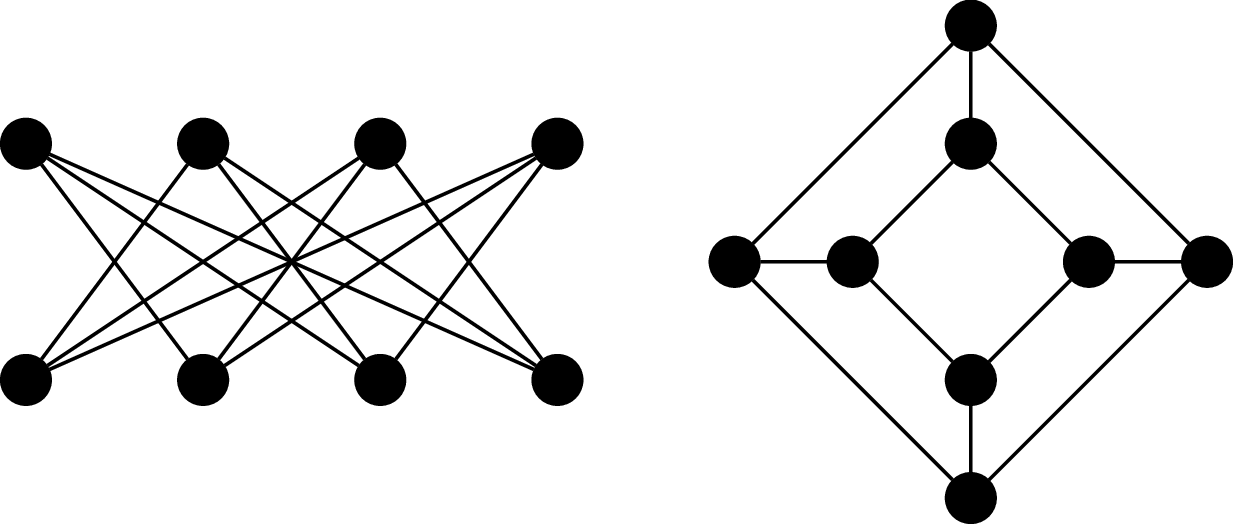
From the perspective of many applications, these graphs represented by
these diagrams would be considered the "same". In fact, these are both
diagrams of the hypercube $Q_3$
Although the visual representation of the graph is very convenient, it is
sometimes misleading, because we're limited to 2D drawings. In fact, there
is a vast area of research devoted to graph drawing and the mathematics of
embedding graphs in two dimensions. The point of this is that two graphs may
look very different, but turn out to be the same.
But even more fundamental than that, we intuitively understand that just
because the graph isn't exactly the same (i.e., the vertices are
named something differently) doesn't mean that we don't want to consider
them equivalent. The next definition is how we define whether two graphs are
basically the same, just with different names or drawings.
An isomorphism between two graphs
$G_1 = (V_1,E_1)$ and $G_2 = (V_2,E_2)$ is a bijection $f:V_1 \to V_2$ which
preserves adjacency. That is, for all vertices $u,v \in V_1$, $u$ and $v$
are adjacent in $G_1$ if and only if $f(u)$ and $f(v)$ are adjacent in
$G_2$. Two graphs $G_1$ and $G_2$ are isomorphic if there
exists an isomorphism between them. When
$G_1$ and $G_2$ are isomorphic, we denote this by $G_1 \cong G_2$.
In other words, we consider two graphs to be the "same" or equivalent if
we can map every vertex to the other graph such that the adjacency
relationship is preserved. In practice, this amounts to a "renaming" of the
vertices, which is what we typically mean when we say that two objects are
isomorphic. Of course, this really means that the edges are preserved.
Consider the following graphs $G_1 = (V_1, E_1)$ and
$G_2 = (V_2, E_2)$.
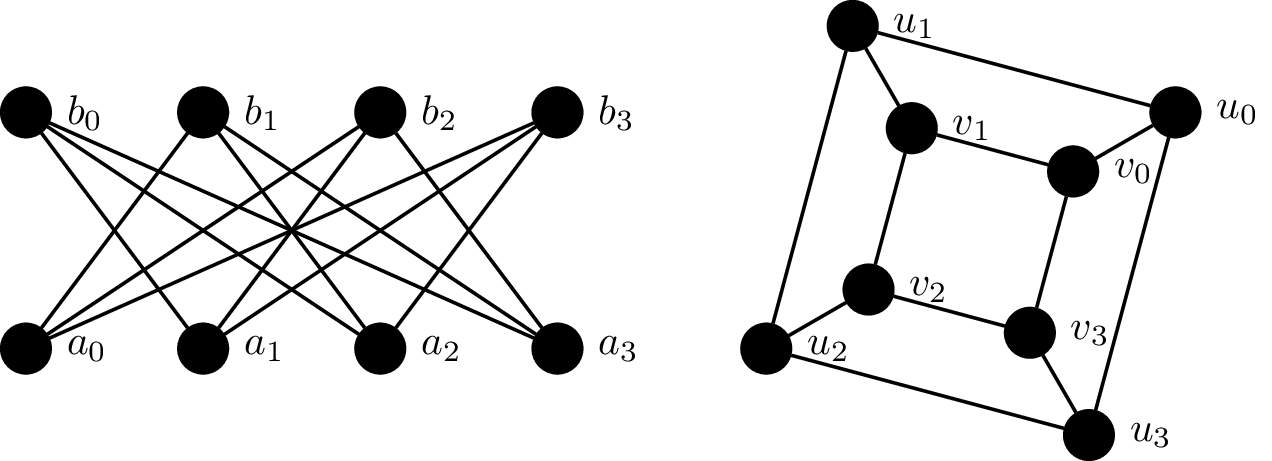
We will show that these two graphs are isomorphic by defining a bijective
function $f:V_1 \to V_2$ which preserves adjacency:
\begin{align*}
f(a_0) &= u_0 & f(a_1) &= v_3 & f(a_2) &= u_2 & f(a_3) &= v_1 \\
f(b_0) &= v_2 & f(b_1) &= u_1 & f(b_2) &= v_0 & f(b_3) &= u_3 \\
\end{align*}
This is a bijection, since every vertex in $V_1$ is paired with a vertex in
$V_2$. We then verify that this bijection preserves adjacency by checking
each edge under the bijection:
\begin{align*}
(f(a_0),f(b_1)) &= (u_0,u_1) & (f(a_0),f(b_2)) &= (u_0,v_0) & (f(a_0),f(b_3)) &= (u_0,u_3) \\
(f(a_1),f(b_0)) &= (v_3,v_2) & (f(a_1),f(b_2)) &= (v_3,v_0) & (f(a_1),f(b_3)) &= (v_3,u_3) \\
(f(a_2),f(b_0)) &= (u_2,v_2) & (f(a_2),f(b_1)) &= (u_2,u_1) & (f(a_2),f(b_3)) &= (u_2,u_3) \\
(f(a_3),f(b_0)) &= (v_1,v_2) & (f(a_3),f(b_1)) &= (v_1,u_1) & (f(a_3),f(b_2)) &= (v_1,v_0)
\end{align*}
Determining if graphs are isomorphic
So an obvious and fundamental problem that arises from this definition is:
Given two graphs $G_1$ and $G_2$, are they isomorphic? The obvious answer is
that we just need to come up with an isomorphism or show that one doesn't exist.
Unfortunately, to do this on a computer, there are $n!$ possible such mappings
we would need to check. In fact, characterizing the complexity of solving the
graph isomorphism problem is one of the most challenging problems in
theoretical computer science. The most
significant progress on this problem
was made in 2015 (and 2017) by our own
Lazlo Babai, who proved that graph
isomorphism can be solved in $2^{O(\log^c
n)}$ time for some constant $c$.
When determining if two specific graphs are isomorphic by hand, however, you
can be clever and take shortcuts. A common tool is isomorphism
invariants.
Let $P$ be a function (or predicate) on graphs. We say
that $P$ is an isomorphism invariant if for all graphs
$G_1,G_2$,
$$
G_1 \cong G_2 \Rightarrow P(G_1)=P(G_2).
$$
For example, $P(G) = |V|$ is clearly an isomorphism invariant, since the
existence of a bijection implies the vertex sets have the same size. We can
also show that $P(G)=|E|$ is an isomorphism invariant (exercise; one simple
approach uses the handshaking lemma).
Here is another useful isomorphism invariant.
The degree sequence of a
graph $G$ is list of degrees of its vertices, in sorted order with repetitions
allowed.
The degree sequence of a graph is an
isomorphism invariant. In other words, if two graphs are isomorphic then they
have the same degree sequence.
Assume $G_1\cong G_2$. We must show that $G_1$ and $G_2$ have
the same degree sequence. Let $v_1,\ldots,v_n$ be the vertices of $G_1$ sorted
by their degree; Then $(\deg(v_1),\ldots,\deg(v_n))$ is the degree sequence of
$G_1$.
Since $G_1\cong G_2$, there exists a bijection $f$ between their vertex sets
that preserves adjacency. Since $f$ is a bijection, the list $(\deg(f(v_1)),
\ldots, \deg(f(v_n)))$ is also a list of the degrees of vertices in $G_2$.
Since $f$ preserves adjacency, for every $v_i$ in $G_1$, $\deg(v_i) =
\deg(f(v_i))$. This means $$(\deg(f(v_1)), \ldots, \deg(f(v_n))) =
(\deg(v_1),\ldots,\deg(v_n)).$$ Thus $(\deg(f(v_1)), \ldots, \deg(f(v_n)))$ is
sorted as well, and is thus the degree sequence of $G_2$ as well as $G_1$.
Flipping around the definition of isomorphism invariant gives the following
very simple theorem.
Let $P$ be an isomorphism invariant and $G_1,G_2$ be graphs.
If $P(G_1)\neq P(G_2),$ then $G_1$ and $G_2$ are not isomorphic.
Here is an example of how this can be used. Consider these graphs:
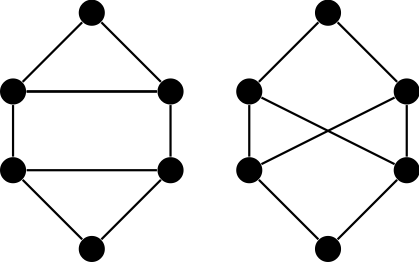
These graphs have the same degree sequence $(3,3,3,3,2,2)$, but they are not
isomorphic; Theorem 10.21 does not apply! Here is one that works: Let $T(G)$ be
the number of "triangles" in $G$ (that is, sets of three vertices that are all
pairwise connected; we could say these are "copies of $K_3$".) This is an
isomorphism invariant (exercise), and $T(G_1) = 2$ while $T(G_2)=0$.
Graph Coloring
A $k$-coloring of a graph $G=(V,E)$ is a
function $c:V \to \{1,2,\ldots,k\}$ such that for all $uv\in E$, $c(u) \neq
c(v)$. A graph is $k$-colorable if there a $k$-coloring of
$G$. For a non-empty graph $G$, we define $\chi(G)$, called the
chromatic number of $G$, to be smallest $k$ such that $G$ is
$k$-colorable.
For any non-empty graph we have $\chi(G) \leq |V|$. An easy way to see why
is to consider the following coloring for a graph of $n$ vertices: just color
each vertex its own color.
We will use $k$-colorability as an invariant to show that two graphs are not
isomorphic.
Consider the following two graphs, $G_1$ and $G_2$.
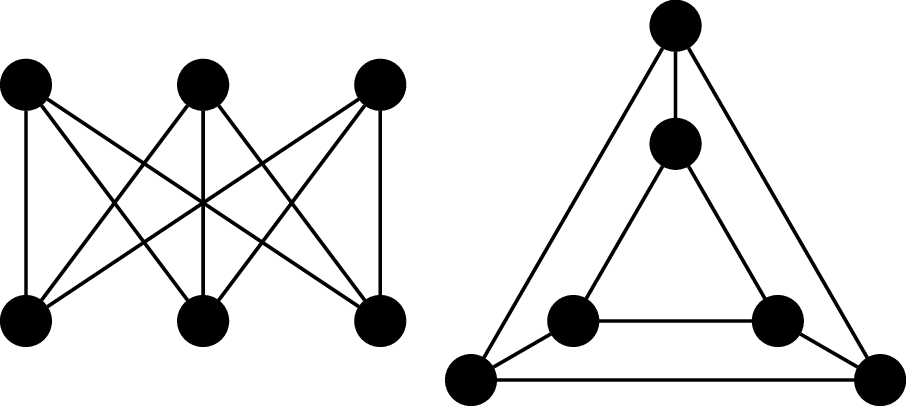
First, we observe that both graphs have 6 vertices and 9 edges and both
graphs are 3-regular. However, we will show that $G_1$ is 2-colorable and $G_2$
is not. To see that $G_1$ is 2-colorable, we observe that the vertices along
the top row can be assigned the same color because they are not adjacent to
each other. Similarly, the vertices along the bottom can be assigned a second
color.

However, $G_2$ contains two triangles and by definition, the vertices
belonging to the same triangle must be colored with 3 different colors. Since
$G_2$ is not 2-colorable, the adjacency relationship among the vertices is not
preserved.





